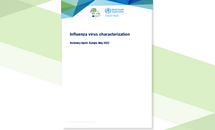Influenza virus characterisation, September 2019
This is the tenth and final report for the 2018–19 influenza season. As of week 39/2019, 205 947 influenza detections across the WHO European Region had been reported; 99% type A viruses, with A(H1N1)pdm09 prevailing over A(H3N2), and 1.2% type B viruses, with 86 of 165 (52%) ascribed to a lineage being B/Yamagata.
Executive summary
Since the July 2019 characterisation report1, a further three shipments of influenza-positive specimens from EU/EEA countries were received at the London WHO CC, the Francis Crick Worldwide Influenza Centre (WIC). A total of 1 511 virus specimens, with collection dates after 31 August 2018, have been received.
The 85 A(H1N1)pdm09 test viruses characterised antigenically since the last report showed equivalent good reactivity with antisera raised against both the A/Michigan/45/2015 2018–19 vaccine virus and the A/Brisbane/02/2018 2019–20 vaccine virus. The 613 test viruses with collection dates from week 40/2018 genetically characterised at the WIC, including two H1N2 reassortants, have all fallen in subclade 6B.1A, defined by S74R, S164T and I295V HA1 substitutions; 564 of these viruses also have HA1 S183P substitution, often with additional substitutions in HA1 and/or HA2.
Since the last report, 37 A(H3N2) viruses successfully recovered had sufficient HA titre to allow antigenic characterisation by HI assay in the presence of oseltamivir; all were poorly recognised by antisera raised against the vaccine virus, eggpropagated A/Singapore/INFIMH-16-0019/2016. Of the 505 viruses with collection dates from week 40/2018 genetically characterised at the WIC, 399 were clade 3C.2a (with 43 3C.2a2, 17 3C.2a3, eight 3C.2a4 and 331 3C.2a1b); 106 were clade 3C.3a.
Ten B/Victoria-lineage viruses have been characterised in this reporting period. All recent viruses have HA1 amino acid substitutions of I117V, N129D, and V146I compared to B/Brisbane/60/2008 (clade 1A), a previous vaccine virus. Groups of viruses defined by deletions of two (Δ162-163, 1A(Δ2)) or three (Δ162-164, 1A(Δ3)) amino acids in HA1 have emerged, with the Δ162-164 group having subgroups of Asian and African origin. These virus groups are antigenically distinguishable by HI assay. Of 20 viruses from EU/EEA countries this season that have been characterised genetically, one has been clade 1A, two 1A(Δ2) and 17 1A(Δ3) (16 African and one Asian subgroup).
Nine B/Yamagata-lineage viruses have been characterised antigenically in this reporting period, giving a total to 23 for the 2018–19 season. All have HA genes that encode HA1 amino acid substitutions of L172Q and M251V compared to, but remain antigenically similar to, the vaccine virus B/Phuket/3073/2013 (clade 3) recommended for use in quadrivalent vaccines for the next northern hemisphere influenza season.
Download







